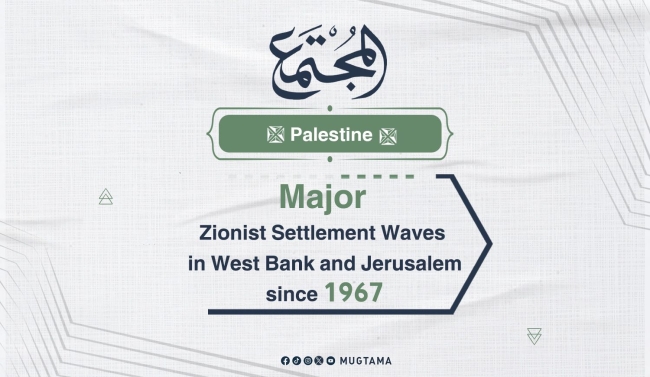Major Zionist Settlement Waves in West Bank and Jerusalem since 1967 Featured
Since 1967, the West Bank and Jerusalem have witnessed a series of settlement waves that constituted radical transformations in the geographical and political situation of the region. Despite the heavy defeat suffered by the Arab countries during that period, it did not lead to the comprehensive displacement of Palestinians as happened in the Nakba of 1948.
After occupying these lands, the Zionist occupation began implementing expansionist strategies aimed at reducing the Palestinian population density and consolidating its control by building new settlements and expanding existing ones.
These waves range between attempts to expand the settlement area by building new settlements and strengthening control over the lands through policies aimed at changing the demographic and geographical reality.
The settlement has gone through several stages, each of which reflects different government policies and specific strategic goals, the most prominent of which are:
- The first wave (1967-1976):
It began immediately after the occupation, as the occupation government aimed to consolidate control over the Palestinian territories and avoid managing the affairs of Palestinian citizens. This stage was characterized by caution in building settlements and attention to basic infrastructure.
The number of settlements established during this period amounted to about 34 settlements. The occupation also demolished the Palestinian Moroccan neighborhood, which was adjacent to the Buraq Wall, and turned it into a Jewish settlement neighborhood in the Old City. These steps were aimed at consolidating the occupation's control over the eastern part of the Holy City.
- The second wave (1977-1987):
With the rise of the right to power in the Zionist entity in 1977, extremist forces rushed to build settlements on the ground for ideological, security, political and economic motives. This period witnessed the establishment of dozens of new settlements and the raising of slogans calling for the deportation of the Palestinians.
98 new settlements were built in the West Bank during that period, most of which was established at the initiative of the ruling right-wing Likud Party and the extremist religious Zionist movement "Gush Emunim", which was active in settlement activities.
- The third wave (1996-2022 AD):
It came in light of the political settlement process that began in the nineties, as the Zionist right sought to obstruct reaching final solutions for fear of handing over Palestinian lands and establishing an independent Palestinian state. This period was characterized by the acceleration of settlement construction to confront any progress in the negotiations.
It aimed to comprehensively Judaize Area (C), which is the area subject to security and administrative occupation according to the Oslo Accords, which constitutes 60% of the area of the West Bank. It also sought to achieve geographical continuity between some distant settlements or between settlement blocs and to expand control over strategic peaks and heights in the West Bank. This wave worked to bring about radical changes in geography and demographics, supporting the settlement project in the West Bank.
The Zionists called them "illegal settlement outposts", a misleading name that aims to downplay the importance and size of this settlement attack, which may be the largest among the waves of settlement in the West Bank.
- The Fourth Wave (2002):
It emerged after the failure of the settlement process and the outbreak of the Second Palestinian Intifada in 2000, as the Zionist leadership believed that the time was right to impose control over as much of the West Bank as possible, so the settlement was greatly expanded and the Palestinian lands were divided into isolated cantons.
This wave was launched under the right's control of the seats of government in the occupying state, as it was initiated by the Prime Minister of the occupation, Ariel Sharon, who assumed leadership between 2001 and 2006, then he was succeeded by Ehud Olmert (2006-2009), and after him Benjamin Netanyahu (2009-2021), all of whom were symbols of the extremist Zionist right that sought to Judaize the West Bank.
These successive waves embody how the occupation sought to change the geographical and political reality in the West Bank and Jerusalem, which greatly affected the lives of Palestinians and complicated the Arab Israeli conflict.


